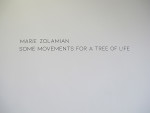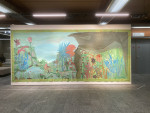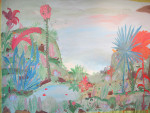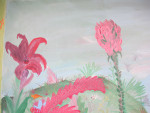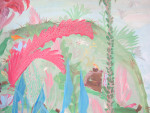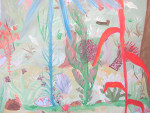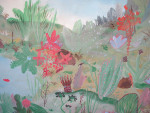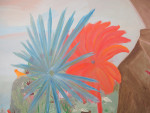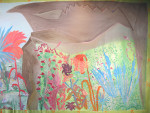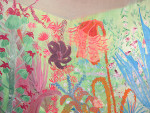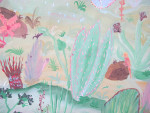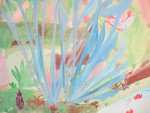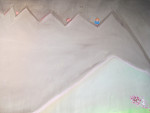SOME MOVEMENTS FOR A TREE OF LIFE
Luk Lambrecht
Voor deze editie selecteerden wij de zeer beloftevolle Marie Zolamian, in 1975 geboren in Beiroet (Libanon) en vandaag leeft en werkt zij in Luik. Als kunstenares koppelt zij het artistiek métier aan inhoudelijke thema's die ons allen én de condities voor onze gezondheid sterk aanspreken én aan-belangen. Haar werk is altijd heel kleurrijk; oogt magisch-realistisch maar blijft verankerd in een rusteloos verlangen om met een ruim publiek te communiceren over wat ons (vooral) schaadt met name het leef-milieu dat ons voortbestaan als mens bedreigt. Haar kunst oogt optimistisch en is inhoudelijk doordrongen van studie en lectuur. Marie Zolamian neemt een aparte plaats in binnen haar generatie en werd onlangs fel opgemerkt met de mozaïek die ze creëerde op het bordes van het zopas geopende KMSK in Antwerpen. Onlangs schitterde ze ook met een tentoonstelling met één ongelooflijk monumentaal doek dat ze presenteerde in kunstcentrum Jester in Genk (C-Mine).
Speciaal voor de UZ Brussel Kunstmuur schilderde ze een fonkelnieuw werk met de mooie, poëtische titel “some movements for a tree of life” van maar liefst 5 bij 2,2 meter - als een soort opvolging van haar monumentaal schilderij dat zij in Genk produceerde.
Toelichting door de kunstenares (citaten uit een gesprek)
Natuurlijk en menselijk, persoonlijk en collectief, gezondheid en milieu zijn de sleutelbegrippen van het schilderij dat ik maakte voor het UZ Brussel op uitnodiging van curator Luk Lambrecht.
De inspiratie van het doek is te vinden bij het begrip "Symbioceen" – in tegenstelling tot het Antropoceen is het Symbioceen een samenleven zonder menselijke overheersing over de omgeving – het zijn gedachten van Glenn Albrecht, een Australische milieufilosoof.
De compositie van dit schilderij dat ik beschouw als een landschap – een wandtapijt in een kader –, is ook gevoed vanuit mijn herinneringen in Beiroet. Het beeld van dit schilderij/wandtapijt vertegenwoordigt een persoonlijk en collectief erfgoed, een geverfde neerslag van beschermde biodiversiteit in een symbiose van "vivre ensemble".
Omdat ik geen donker en rampzalig landschap wil afbeelden, schilder ik een “koninkrijk” dat uitsluitend bestaat uit vogels en hybride, woekerende vegetatie, en laat ik de mensen buiten het toneel, als toeschouwers, om te zien wat er zal gebeuren.
Ik schilderde het werk vanuit dit uitgangspunt, zonder schetsen of studies en al de rest ontstond tijdens de opeenvolgende schildermomenten. Deze vrije manier van schilderen stelt mij in staat te experimenteren met een nieuwe ruimte en daarin met verf te spelen, om vanuit mezelf een nieuwe ruimte te bedenken die (hopelijk) zal mij verrassen en de kijker zal verbazen.
Het is een scène met vogels en vegetatie via een spel van kleuren, transparanties, ongelukken en worstelingen met de verf op het doek. Ik zie het schilderij in zijn geheel als één gigantische miniatuur; met invloeden en details die zich verstrengelen via nieuwe en andere perspectieven, vervlechtingen, herhalingen, geometrieën en kleuren die elkaar confronteren. Eén kaart die lijkt op een “chimerenkaart”, waar het verhaal wordt verteld met en vanuit verschillende (verhaal)-lijnen.
Pour cette édition, nous avons sélectionné la très prometteuse Marie Zolamian, née à Beyrouth (Liban) en 1975, qui vit et travaille aujourd'hui à Liège. Marie Zolamian lie le métier artistique à des thèmes de fond qui nous interpellent tous fortement et aux conditions de notre santé. Son travail est toujours très coloré ; il a l'air féerique et réaliste mais reste ancré dans un désir inébranlable de communiquer à un large public ce qui nous fait (principalement) du mal, notamment l'environnement qui menace notre survie en tant qu'êtres humains. Son art semble optimiste et son contenu est imprégné d'étude et de lecture. Marie Zolamian occupe une place à part dans sa génération et s'est récemment fait remarquer par la mosaïque qu'elle a conçue sur les marches du KMSKA nouvellement ouvert à Anvers. Elle a également brillé récemment avec une exposition présentant une incroyable toile monumentale qu'elle a présentée au centre d'art Jester à Genk (C-Mine).
Spécialement pour l'UZ Brussel Kunstmuur, elle a peint une toute nouvelle œuvre au titre magnifique et poétique de "Quelques mouvements pour un arbre de vie" mesurant pas moins de 5 mètres sur 2,2 mètres - comme une sorte de suite de sa peinture monumentale réalisée à Genk.
Commentaires de l'artiste (citations tirées d'une interview)
Naturel et humain, personnel et collectif, santé et environnement sont les concepts clés du tableau que j’ai réalisé pour l'UZ Brussel sur invitation du curateur Luk Lambrecht.
L'inspiration de la toile se trouve dans le concept de "Symbiocène" – contrairement à l'Anthropocène, le Symbiocène est une coexistence sans domination humaine sur l'environnement – ce sont les pensées de Glenn Albrecht, un philosophe environnemental australien.
La composition de cette peinture que je considère comme un paysage – une tapisserie dans un cadre –, est également nourrie de mes souvenirs à Beyrouth. L'image de cette peinture/tapisserie murale représente un patrimoine personnel et collectif, un reflet peint de la biodiversité protégée dans une symbiose de "vivre ensemble".
Comme je ne veux pas dépeindre un paysage sombre et désastreux, je peins un "royaume" composé uniquement d'oiseaux et de végétation hybride envahissante, et je laisse les humains hors de la scène, en observateurs, pour voir ce qui va se passer.
J'ai peint l'œuvre à partir de ce point de départ, sans croquis ni études, et tout le reste est apparu au cours des moments successifs de la peinture. Cette façon libre de peindre me permet d'expérimenter un nouvel espace et d'y jouer avec la peinture, d'inventer de l'intérieur un nouvel espace qui (je l’espère) me surprendra et étonnera le regardeur.
C'est une scène avec des oiseaux et de la végétation à travers un jeu de couleurs, de transparences, d’accidents et de luttes avec la peinture sur la toile. Je vois le tableau dans son ensemble comme une gigantesque miniature ; avec des influences et des détails qui s'entrecroisent à travers des perspectives nouvelles et différentes, des entrelacements, des répétitions, des géométries et des couleurs qui se confrontent. Une carte similaire à une "carte chimère" où l'histoire est racontée avec et à partir de diverses lignes (de récit).
For this edition, we selected the very promising Marie Zolamian, who was born in Beirut (Lebanon) in 1975 and now lives and works in Liège. She links artistic craftsmanship to substantive themes that strongly appeal to us all and to the conditions of our health. Her work is always very colourful; looks magical-realistic but remains anchored in a restless desire to communicate to a broad public about what (mainly) harms us, especially the environment that threatens our survival as human beings. Her art looks optimistic and its content steeped in research and reading. Marie Zolamian occupies a distinct place within her generation and was recently brightly noticed with the mosaic she created on the steps of the newly opened KMSK in Antwerp. She also recently shone with an exhibition featuring one incredible monumental canvas that she presented at the art centre Jester in Genk (C-Mine).
Especially for the UZ Brussel Kunstmuur, she painted a brand new work with the beautiful, poetic title «Some movements for a tree of life» measuring no less than 5 by 2.2 metres - as a kind of follow-up to her monumental painting she produced in Genk.
Comments by the artist (quotes from an interview)
Natural and human, personal and collective, health and environment are the key concepts of the painting I made for UZ Brussel at the invitation of curator Luk Lambrecht.
The inspiration for the canvas lies in the concept of the “Symbiocene” – unlike the Anthropocene, the Symbiocene is a coexistence without human domination over the environment – these are the thoughts of Glenn Albrecht, an Australian environmental philosopher.
The composition of this painting, which I consider a landscape – a tapestry within a frame – is also nourished by my memories of Beirut. The image of this painted/wall tapestry represents a personal and collective heritage, a painted reflection of biodiversity protected in a symbiosis of “living together”.
As I do not want to depict a dark and disastrous landscape, I paint a “realm” composed only of birds and hybrid invasive vegetation, and I leave humans out of the scene, as observers, to see what will happen.
I painted the work from this starting point, without sketches or studies, and everything else appeared during the successive moments of painting. This free way of painting allows me to experiment with a new space and to play there with paint, to invent from within a new space that (I hope) will surprise me and astonish the viewer.
It is a scene with birds and vegetation through a play of colours, transparencies, accidents and struggles with the paint on the canvas. I see the painting as a whole as a gigantic miniature; with influences and details that intersect through new and different perspectives, interlacings, repetitions, geometries and colours that confront one another. A map similar to a “chimera map” where the story is told with and from various (narrative) lines.
